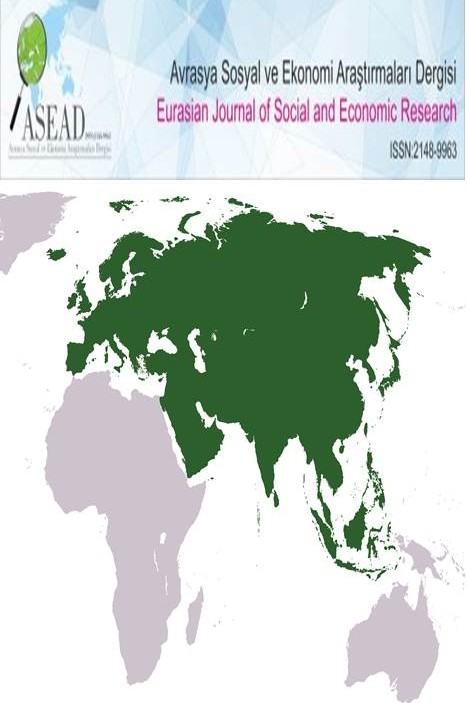BRAIN DRAIN IN TURKEY: AN INVESTIGATION ON THE LEADING MOTIVES OF SKILLED MIGRATION
International Labor Migration, Human Capital, Skilled Migration, Brain Drain
___
- BAUER, T., & ZIMMERMANN, K. F. (1999). Assessment of Possible Migration Pressure And Its Labour Market Impact Following EU Enlargement to Central and Eastern Europe (Vol. 3). Bonn: IZA. BECKER, G. S. (1975). Human Capital: A Theoretical and Empirical Analysis, National Bureau of Economic Research, 22. BODVARSSON, Ö. B., & VAN DEN BERG, H. (2013). The Economics of Immigration: Theory and Policy (2 ed.). New York: Springer. BODVARSSON, Ö. B., SIMPSON , N. B., & SPARBER, C. (2015). Migration Theory. In B. R. Chiswick, & P. W. Miller, Handbook of Economic of International Migration (pp. 15-26). BORJAS, G. J. (1987). Self-Selection and the Earnings of Immigrants. American Economic Review, 77(4), 531-553. BORJAS, G. J. (1991). Immigration And Self-Selection. In Immigration, Trade, And The Labor Market. University of Chicago Press, 29-76. BRUCHER, H., CAPUANO, S., & MARFOUK, A. (2013). Education, Gender And International Migration: Insights From A Panel-Dataset 1980-2010. Retrieved from http://www.iab.de/en/daten/iab-brain-drain-data.aspx ETZO, I. (2008, May 18). Internal Migration: A Review of The Literature. Munich Personal RePEc Archive: http://mpra.ub.uni-muenchen.de/8783/ GLOSSARY, I.O.M. (2011). International Migration Law : Glossary On Migration. Retrieved From International Organization For Migration (IOM): http://www. turkey. iom. int/documents/goc_terimleri_sozlugu. pdf GOSS , E., & PAUL, C. (1986). Age And Work Experience In The Decision To Migrate. The Journal of Human Resources, 21(3), 397--405. GREENWOOD, M. J. (1997). Internal Migration in Developed Countries. In M. R. Rosenzweig, & O. Stark, Handbook of Population and Family Economics (pp. 647-720). Gulf Proffessional Publishing. GÜNGÖR, N. D. (2003). Brain Drain From Turkey: An Empirical Investigation Of The Determinants Of Skilled Migration And Student Non-Return. The Graduate School of Social Sciences of METU Department of Economics (Ph.D. Thesis). HARRIS, J. R., & TODARO, M. P. (1970). Association Migration, Unemployment and Development: A Two-Sector Analysis. The American Economic Review, 60(1), 126-142. JOHNSTON, W. B. (1991). Global Work Force 2000: The New World Labor Market. Harward Business Review(March - April ). LALONDE, R. J., & TOPEL, R. H. (1997). Economic Impact of Internatonal Migration and the Economic Performance of Migrants. In M. R. Rosenzweig, & O. Stark, Handbook of Population and Family Economics (Vol. 1b, pp. 800-847). North Holland. LEE, E. (1966). A Theory of Migration. Demography, 3(1), 47-57. Retrieved from http://www.jstor.org/stable/2060063 LUCAS Jr, R. (1988). On The Mechanics Of Economic Development. Journal of Monetary Economics, 22(1), 3-42. MASSEY, D. S., ARANGO, J., HUGO, G., KOUAOUCI, A., PELLEGRINO, A., & EDWARD, J. (1993, September). Theories of International Migration: A Review and Appraisal. Population and Development Review, 19(3), 431-466. ÖZCAN, D. E. (2017). Çağdaş Göç Teorileri Üzerine Bir Değerlendirme. İş ve Hayat Dergisi, Ekonomi, Hukuk ve Sosyal Politika, 4, 183-215. POLACHEK, S., & HORVATH, F. W. (2012, 01). A Life Cycle Approach to Migration: Analysis of the Perspicacious Peregrinator. Research in Labor Economics, 53, 349-395. doi:10.1108/S0147-9121(2012)0000035037 ROMER, P. M. (1987). Growth Based On Increasing Returns Due To Specialization. The American Economic Review, 77(2), 56-62. ROMER, P. M. (1986). Increasing Returns And Long-Run Growth. Journal of Political Economy, 94(5), 1002-1037. SHIELDS, G. M., & SHIELDS, M. P. (1989). The Emergence of Migration Theory and Suggested New Direction. Journal of Economic Survey, 3(4), 277-304. doi:09.50-0804/89/04 0277-28 SJAASTAD, L. A. (1962). The Costs and Returns of Human Migration. Journal of Political Economy, 70(5), 80-93. The UN Migration Agency. (2018). World Migration Report. Geneva: International Organization for Migration (IOM). Retrieved from https://publications.iom.int/system/files/pdf/wmr_2018_en.pdf TIEBOUT, C. M. (1956, Oct.). A Pure Theory of Local Expenditures. The Journal of Political Economy (64), 416-424. UN. (2017). International Migration Report [highlights]. Retrieved from http://www.un.org/en/development/desa/population/migration/publications/migrationreport/docs/MigrationReport2017_Highlights.pdf
- Yayın Aralığı: Yılda 4 Sayı
- Başlangıç: 2014
- Yayıncı: İrfan TÜRKOĞLU
KAMU HASTANELERİNDE VERİMLİLİK ÖLÇÜMÜ: AKDENİZ BÖLGESİ ÖRNEĞİ
İSLAM’IN ŞİDDET VE TERÖRE BAKIŞI
KAMU KURUMLARINDA İTİBAR YÖNETİMİ: KURUMSAL İTİBARI ÖLÇME VE DEĞERLENDİRME
Ferit İZCİ, Yıldız ATMACA, Vedat YILMAZ
GENÇ VE YETİŞKİNLERDE DUYGUSAL ZEKÂ ve MUTLULUK DÜZEYİNİN BAZI DEĞİŞKENLERE GÖRE İNCELENMESİ
KÜLTÜRLERARASI İLETİŞİM: KAZAKİSTAN’DA ÇOK DİLLİLİK SORUNLARI
ÜLKER KÖKSAL’IN TİYATROLARINDA KÖYDEN KENTE GÖÇ
Zeki TAŞTAN, Mehmet TÜTAK, Burcu TÜTAK
